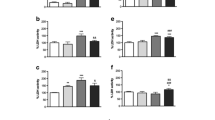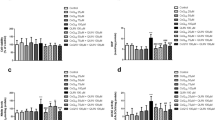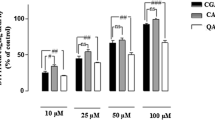Abstract
Excessive formation of reactive oxygen species (ROS) and disruption of glutamate uptake have been hypothesized as key mechanisms contributing to quinolinic acid (QA)-induced toxicity. Thus, here we investigate if the use of diphenyl diselenide (PhSe)2, guanosine (GUO) and MK-801, alone or in combination, could protect rat brain slices from QA-induced toxicity. QA (1 mM) increased ROS formation, thiobarbituric acid reactive substances (TBARS) and decreased cell viability after 2 h of exposure. (PhSe)2 (1 μM) protected against this ROS formation in the cortex and the striatum and also prevented decreases in cell viability induced by QA. (PhSe)2 (5 μM) prevented ROS formation in the hippocampus. GUO (10 and 100 μM) blocked the increase in ROS formation caused by QA and MK-801 (20 and 100 μM) abolished the pro-oxidant effect of QA. When the noneffective concentrations were used in combination produced a decrease in ROS formation, mainly (PhSe)2 + GUO and (PhSe)2 + GUO + MK-801. These results demonstrate that this combination could be effective to avoid toxic effects caused by high concentrations of QA. Furthermore, the data obtained in the ROS formation and cellular viability assays suggest different pathways in amelioration of QA toxicity present in the neurodegenerative process.







Similar content being viewed by others
References
Coyle JT, Puttfarcken P (1993) Oxidative stress, glutamate, and neurodegenerative disorders. Science 262(5134):689–695. doi:10.1126/science.7901908
Schuck PF, Tonin A, da Costa Ferreira G, Rosa RB, Latini A, Balestro F, Perry ML, Wannmacher CM, de Souza Wyse AT, Wajner M (2007) In vitro effect of quinolinic acid on energy metabolism in brain of young rats. Neurosci Res 57(2):277–288. doi:10.1016/j.neures.2006.10.013
Stone TW, Behan WM, MacDonald M, Darlington LG (2000) Possible mediation of quinolinic acid-induced hippocampal damage by reactive oxygen species. Amino Acids 19(1):275–281. doi:10.1007/s007260070059
Vega-Naredo I, Poeggeler B, Sierra-Sanchez V, Caballero B, Tomas-Zapico C, Alvarez-Garcia O, Tolivia D, Rodriguez-Colunga MJ, Coto-Montes A (2005) Melatonin neutralizes neurotoxicity induced by quinolinic acid in brain tissue culture. J Pineal Res 39(3):266–275. doi:10.1111/j.1600-079X.2005.00243.x
Perkins MN, Stone TW (1983) Pharmacology and regional variations of quinolinic acid-evoked excitations in the rat central nervous system. J Pharmacol Exp Ther 226(2):551–557
Tavares RG, Tasca CI, Santos CE, Alves LB, Porciuncula LO, Emanuelli T, Souza DO (2002) Quinolinic acid stimulates synaptosomal glutamate release and inhibits glutamate uptake into astrocytes. Neurochem Int 40(7):621–627. doi:10.1016/S0197-0186(01)00133-4
Tavares RG, Tasca CI, Santos CE, Wajner M, Souza DO, Dutra-Filho CS (2000) Quinolinic acid inhibits glutamate uptake into synaptic vesicles from rat brain. NeuroReport 11(2):249–253. doi:10.1097/00001756-200002070-00005
Braidy N, Grant R, Adams S, Brew BJ, Guillemin GJ (2009) Mechanism for quinolinic acid cytotoxicity in human astrocytes and neurons. Neurotox Res 16(1):77–86. doi:10.1007/s12640-009-9051-z
Finkbeiner S, Cuervo AM, Morimoto RI, Muchowski PJ (2006) Disease-modifying pathways in neurodegeneration. J Neurosci 26(41):10349–10357. doi:10.1523/JNEUROSCI.3829-06.2006
Guillemin GJ, Brew BJ (2002) Implications of the kynurenine pathway and quinolinic acid in Alzheimer’s disease. Redox Rep 7(4):199–206. doi:10.1179/135100002125000550
Guillemin GJ, Kerr SJ, Brew BJ (2005) Involvement of quinolinic acid in AIDS dementia complex. Neurotox Res 7(1–2):103–123. doi:10.1007/BF03033781
Frizzo ME, Lara DR, Dahm KC, Prokopiuk AS, Swanson RA, Souza DO (2001) Activation of glutamate uptake by guanosine in primary astrocyte cultures. NeuroReport 12(4):879–881. doi:10.1097/00001756-200103260-00051
Schmidt AP, Avila TT, Souza DO (2005) Intracerebroventricular guanine-based purines protect against seizures induced by quinolinic acid in mice. Neurochem Res 30(1):69–73
Frizzo ME, Antunes Soares FA, Dall’Onder LP, Lara DR, Swanson RA, Souza DO (2003) Extracellular conversion of guanine-based purines to guanosine specifically enhances astrocyte glutamate uptake. Brain Res 972(1–2):84–89. doi:10.1016/S0006-8993(03)02506-X
Soares FA, Schmidt AP, Farina M, Frizzo ME, Tavares RG, Portela LV, Lara DR, Souza DO (2004) Anticonvulsant effect of GMP depends on its conversion to guanosine. Brain Res 1005(1–2):182–186. doi:10.1016/j.brainres.2004.01.053
Kachur AV, Manevich Y, Biaglow JE (1997) Effect of purine nucleoside phosphates on OH-radical generation by reaction of Fe2+ with oxygen. Free Radic Res 26(5):399–408. doi:10.3109/10715769709084476
Saute JA, da Silveira LE, Soares FA, Martini LH, Souza DO, Ganzella M (2006) Amnesic effect of GMP depends on its conversion to guanosine. Neurobiol Learn Mem 85(3):206–212. doi:10.1016/j.nlm.2005.10.006
Biaglow JE, Held KD, Manevich Y, Tuttle S, Kachur A, Uckun F (1996) Role of guanosine triphosphate in ferric ion-linked Fenton chemistry. Radiat Res 145(5):554–562. doi:10.2307/3579273
Gudkov SV, Shtarkman IN, Smirnova VS, Chernikov AV, Bruskov VI (2006) Guanosine and inosine display antioxidant activity, protect DNA in vitro from oxidative damage induced by reactive oxygen species, and serve as radioprotectors in mice. Radiat Res 165(5):538–545. doi:10.1667/RR3552.1
Nogueira CW, Zeni G, Rocha JB (2004) Organoselenium and organotellurium compounds: toxicology and pharmacology. Chem Rev 104(12):6255–6285. doi:10.1021/cr0406559
Rossato JI, Ketzer LA, Centuriao FB, Silva SJ, Ludtke DS, Zeni G, Braga AL, Rubin MA, Rocha JB (2002) Antioxidant properties of new chalcogenides against lipid peroxidation in rat brain. Neurochem Res 27(4):297–303. doi:10.1023/A:1014907228580
Maciel EN, Bolzan RC, Braga AL, Rocha JB (2000) Diphenyl diselenide and diphenyl ditelluride differentially affect delta-aminolevulinate dehydratase from liver, kidney, and brain of mice. J Biochem Mol Toxicol 14(6):310–319. doi:10.1002/1099-0461(2000)14:6<310:AID-JBT3>3.0.CO;2-D
Nogueira CW, Rotta LN, Perry ML, Souza DO, da Rocha JB (2001) Diphenyl diselenide and diphenyl ditelluride affect the rat glutamatergic system in vitro and in vivo. Brain Res 906(1–2):157–163. doi:10.1016/S0006-8993(01)02165-5
Nogueira CW, Rotta LN, Zeni G, Souza DO, Rocha JB (2002) Exposure to ebselen changes glutamate uptake and release by rat brain synaptosomes. Neurochem Res 27(4):283–288. doi:10.1023/A:1014903127672
Nogueira CW, Meotti FC, Curte E, Pilissao C, Zeni G, Rocha JB (2003) Investigations into the potential neurotoxicity induced by diselenides in mice and rats. Toxicology 183(1–3):29–37. doi:10.1016/S0300-483X(02)00423-7
Santamaria A, Rios C (1993) MK-801, an N-methyl-d-aspartate receptor antagonist, blocks quinolinic acid-induced lipid peroxidation in rat corpus striatum. Neurosci Lett 159(1–2):51–54. doi:10.1016/0304-3940(93)90796-N
Bueno A, De Olmos S, Heimer L, De Olmos J (2003) NMDA-antagonist MK-801-induced neuronal degeneration in Wistar rat brain detected by the Amino-Cupric-Silver method. Exp Toxicol Pathol 54(4):319–334. doi:10.1078/0940-2993-00264
Sharp FR, Jasper P, Hall J, Noble L, Sagar SM (1991) MK-801 and ketamine induce heat shock protein HSP72 in injured neurons in posterior cingulate and retrosplenial cortex. Ann Neurol 30(6):801–809. doi:10.1002/ana.410300609
Paulmier C (1986) Selenoorganic functional groups. In: Paulmier C (ed) Selenium reagents and intermediates in organic synthesis, 1st edn. Pergamon Press, Oxford
Dal-Cim T, Martins WC, Santos AR, Tasca CI (2011) Guanosine is neuroprotective against oxygen/glucose deprivation in hippocampal slices via large conductance Ca(2)+-activated K+ channels, phosphatidilinositol-3 kinase/protein kinase B pathway activation and glutamate uptake. Neuroscience 183:212–220. doi:10.1016/j.neuroscience.2011.03.022
Molz S, Decker H, Oliveira IJ, Souza DO, Tasca CI (2005) Neurotoxicity induced by glutamate in glucose-deprived rat hippocampal slices is prevented by GMP. Neurochem Res 30(1):83–89
Oliveira IJ, Molz S, Souza DO, Tasca CI (2002) Neuroprotective effect of GMP in hippocampal slices submitted to an in vitro model of ischemia. Cell Mol Neurobiol 22(3):335–344
Hempel SL, Buettner GR, O’Malley YQ, Wessels DA, Flaherty DM (1999) Dihydrofluorescein diacetate is superior for detecting intracellular oxidants: comparison with 2′,7′-dichlorodihydrofluorescein diacetate, 5(and 6)-carboxy-2′,7′-dichlorodihydrofluorescein diacetate, and dihydrorhodamine 123. Free Radic Biol Med 27(1–2):146–159. doi:10.1016/S0891-5849(99)00061-1
Ohkawa H, Ohishi N, Yagi K (1979) Assay for lipid peroxides in animal tissues by thiobarbituric acid reaction. Anal Biochem 95(2):351–358. doi:10.1016/0003-2697(79)90738-3
Mosmann T (1983) Rapid colorimetric assay for cellular growth and survival: application to proliferation and cytotoxicity assays. J Immunol Methods 65(1–2):55–63. doi:10.1016/0022-1759(83)90303-4
Lowry OH, Rosebrough NJ, Farr AL, Randall RJ (1951) Protein measurement with the Folin phenol reagent. J Biol Chem 193(1):265–275
Brana C, Benham C, Sundstrom L (2002) A method for characterising cell death in vitro by combining propidium iodide staining with immunohistochemistry. Brain Res Brain Res Protoc 10(2):109–114
Ganzella M, Jardim FM, Boeck CR, Vendite D (2006) Time course of oxidative events in the hippocampus following intracerebroventricular infusion of quinolinic acid in mice. Neurosci Res 55(4):397–402. doi:10.1016/j.neures.2006.05.003
Lisy V, Stastny F (2002) Nitric oxide synthase inhibition and glutamate binding in quinolinate-lesioned rat hippocampus. Physiol Res 51(3):299–307
Behan WM, McDonald M, Darlington LG, Stone TW (1999) Oxidative stress as a mechanism for quinolinic acid-induced hippocampal damage: protection by melatonin and deprenyl. Br J Pharmacol 128(8):1754–1760. doi:10.1038/sj.bjp.0702940
Behan WM, Stone TW (2002) Enhanced neuronal damage by co-administration of quinolinic acid and free radicals, and protection by adenosine A2A receptor antagonists. Br J Pharmacol 135(6):1435–1442. doi:10.1038/sj.bjp.0704613
Rios C, Santamaria A (1991) Quinolinic acid is a potent lipid peroxidant in rat brain homogenates. Neurochem Res 16(10):1139–1143
Perez Velazquez JL, Frantseva MV, Carlen PL (1997) In vitro ischemia promotes glutamate-mediated free radical generation and intracellular calcium accumulation in hippocampal pyramidal neurons. J Neurosci 17(23):9085–9094
Atlante A, Gagliardi S, Minervini GM, Ciotti MT, Marra E, Calissano P (1997) Glutamate neurotoxicity in rat cerebellar granule cells: a major role for xanthine oxidase in oxygen radical formation. J Neurochem 68(5):2038–2045. doi:10.1046/j.1471-4159.1997.68052038.x
Hartley DM, Kurth MC, Bjerkness L, Weiss JH, Choi DW (1993) Glutamate receptor-induced 45Ca2+ accumulation in cortical cell culture correlates with subsequent neuronal degeneration. J Neurosci 13(5):1993–2000
Castilho RF, Kowaltowski AJ, Vercesi AE (1996) The irreversibility of inner mitochondrial membrane permeabilization by Ca2+ plus prooxidants is determined by the extent of membrane protein thiol cross-linking. J Bioeng Biomembr 28(6):523–529. doi:10.1007/BF02110442
Sousa SC, Maciel EN, Vercesi AE, Castilho RF (2003) Ca2+-induced oxidative stress in brain mitochondria treated with the respiratory chain inhibitor rotenone. FEBS Lett 543(1–3):179–183. doi:10.1016/S0014-5793(03)00421-6
Roos DH, Puntel RL, Santos MM, Souza DO, Farina M, Nogueira CW, Aschner M, Burger ME, Barbosa NB, Rocha JB (2009) Guanosine and synthetic organoselenium compounds modulate methylmercury-induced oxidative stress in rat brain cortical slices: involvement of oxidative stress and glutamatergic system. Toxicol In Vitro 23(2):302–307. doi:10.1016/j.tiv.2008.12.020
Santamaria A, Salvatierra-Sanchez R, Vazquez-Roman B, Santiago-Lopez D, Villeda-Hernandez J, Galvan-Arzate S, Jimenez-Capdeville ME, Ali SF (2003) Protective effects of the antioxidant selenium on quinolinic acid-induced neurotoxicity in rats: in vitro and in vivo studies. J Neurochem 86(2):479–488. doi:10.1046/j.1471-4159.2003.01857.x
Paoletti P (2011) Molecular basis of NMDA receptor functional diversity. Eur J Neurosci 33(8):1351–1365. doi:10.1111/j.1460-9568.2011.07628.x
Avila DS, Gubert P, Palma A, Colle D, Alves D, Nogueira CW, Rocha JB, Soares FA (2008) An organotellurium compound with antioxidant activity against excitotoxic agents without neurotoxic effects in brain of rats. Brain Res Bull 76(1–2):114–123. doi:10.1016/j.brainresbull.2007.12.008
Perez-De La Cruz V, Gonzalez-Cortes C, Galvan-Arzate S, Medina-Campos ON, Perez-Severiano F, Ali SF, Pedraza-Chaverri J, Santamaria A (2005) Excitotoxic brain damage involves early peroxynitrite formation in a model of Huntington’s disease in rats: protective role of iron porphyrinate 5,10,15,20-tetrakis (4-sulfonatophenyl)porphyrinate iron (III). Neuroscience 135(2):463–474. doi:10.1016/j.neuroscience.2005.06.027
Sas K, Robotka H, Toldi J, Vecsei L (2007) Mitochondria, metabolic disturbances, oxidative stress and the kynurenine system, with focus on neurodegenerative disorders. J Neurol Sci 257(1–2):221–239. doi:10.1016/j.jns.2007.01.033
Danbolt NC (2001) Glutamate uptake. Prog Neurobiol 65(1):1–105. doi:10.1016/S0301-0082(00)00067-8
Vinade ER, Schmidt AP, Frizzo ME, Izquierdo I, Elisabetsky E, Souza DO (2003) Chronically administered guanosine is anticonvulsant, amnesic and anxiolytic in mice. Brain Res 977(1):97–102. doi:10.1016/S0006-8993(03)02769-0
Lara DR, Schmidt AP, Frizzo ME, Burgos JS, Ramirez G, Souza DO (2001) Effect of orally administered guanosine on seizures and death induced by glutamatergic agents. Brain Res 912(2):176–180. doi:10.1016/S0006-8993(01)02734-2
Santos TG, Souza DO (1070) Tasca CI (2006) GTP uptake into rat brain synaptic vesicles. Brain Res 1:71–76. doi:10.1016/j.brainres.2005.10.099
Molz S, Tharine DC, Decker H, Tasca CI (2008) GMP prevents excitotoxicity mediated by NMDA receptor activation but not by reversal activity of glutamate transporters in rat hippocampal slices. Brain Res 1231:113–120. doi:10.1016/j.brainres.2008.07.009
Ciccarelli R, Di Iorio P, Giuliani P, D’Alimonte I, Ballerini P, Caciagli F, Rathbone MP (1999) Rat cultured astrocytes release guanine-based purines in basal conditions and after hypoxia/hypoglycemia. Glia 25(1):93–98. doi:10.1002/(SICI)1098-1136(19990101)25:1<93:AID-GLIA9>3.0.CO;2-N
Ellison G (1994) Competitive and non-competitive NMDA antagonists induce similar limbic degeneration. NeuroReport 5(18):2688–2692. doi:10.1097/00001756-199412000-00070
Price DL (1999) New order from neurological disorders. Nature 399(6738 Suppl):A3–A5
Liddell JR, Hoepken HH, Crack PJ, Robinson SR, Dringen R (2006) Glutathione peroxidase 1 and glutathione are required to protect mouse astrocytes from iron-mediated hydrogen peroxide toxicity. J Neurosci Res 84(3):578–586. doi:10.1002/jnr.20957
Dringen R, Pawlowski PG, Hirrlinger J (2005) Peroxide detoxification by brain cells. J Neurosci Res 79(1–2):157–165. doi:10.1002/jnr.20280
Zhao R, Holmgren A (2004) Ebselen is a dehydroascorbate reductase mimic, facilitating the recycling of ascorbate via mammalian thioredoxin systems. Antioxid Redox Signal 6(1):99–104. doi:10.1089/152308604771978390
Collingridge GL, Lester RA (1989) Excitatory amino acid receptors in the vertebrate central nervous system. Pharmacol Rev 41(2):143–210
Ozawa S, Kamiya H, Tsuzuki K (1998) Glutamate receptors in the mammalian central nervous system. Prog Neurobiol 54(5):581–618
Lipton SA, Rosenberg PA (1994) Excitatory amino acids as a final common pathway for neurologic disorders. N Engl J Med 330(9):613–622. doi:10.1056/NEJM199403033300907
Acknowledgments
This work was supported by the FINEP research grant “Rede Instituto Brasileiro de Neurociência (IBN-Net)” # 01.06.0842-00, INCT for Excitotoxicity and Neuroprotection-MCT/CNPq. J.B.T.R and F.A.A.S. receive a fellowship by CNPq. F.D. and C.L.D.C. receive a fellowship by CAPES. Additional support giving by FAPERGS and CAPES. This work was revised by BioMed Proofreading.
Author information
Authors and Affiliations
Corresponding author
Rights and permissions
About this article
Cite this article
Dobrachinski, F., Bastos, L.L., Bridi, J.C. et al. Cooperation of Non-Effective Concentration of Glutamatergic System Modulators and Antioxidant Against Oxidative Stress Induced by Quinolinic Acid. Neurochem Res 37, 1993–2003 (2012). https://doi.org/10.1007/s11064-012-0820-3
Received:
Revised:
Accepted:
Published:
Issue Date:
DOI: https://doi.org/10.1007/s11064-012-0820-3




